#Former president Richard Nixon
Explore tagged Tumblr posts
Text
the fucking. richard nixon quote in taking hwats not yours????????
2 notes
·
View notes
Text
nice out fit loser. 1974 called, apparently president gerald ford has granted a full and unconditional pardon to former president richard nixon
3K notes
·
View notes
Text
As president of the United States, Donald Trump threatened the federally issued licenses of television broadcast outlets that displeased him. In 2017, after NBC News reported a dispute between the president and his military advisors about the size of the nuclear arsenal, the president launched a series of tweets:
These 2017 tweets did not specifically suggest that he would have the Federal Communications Commission (FCC), which issues the airwave licenses, revoke them on his order. Instead, they appear to echo the 1972 tactics of Richard Nixon, who, displeased by coverage from the Washington Post, encouraged a third party to file a challenge at the FCC (which ultimately went nowhere).
In response to the 2017 tweets, the Trump-appointed chairman of the FCC, Ajit Pai, took a firm stand. “I believe in the First Amendment,” he said. “Under the law, the FCC does not have the authority to revoke a license of a broadcast station based on a particular newscast.”
Now, in 2024, as a presidential candidate, Donald Trump has reasserted that broadcasters who displease him should lose their federal airwave licenses. A September 2023 post on Truth Social accused NBC of “Country Threatening Treason.” He added, “Why should NBC, or any of the other corrupt & dishonest media companies, be entitled to use the very valuable Airwaves of the USA, FREE?”
The current Chair of the FCC, Jessica Rosenworcel, responded, “the First Amendment is a cornerstone of our democracy. The FCC does not and will not revoke licenses for broadcast stations simply because a political candidate disagrees with or dislikes content or coverage.”
However, the ability of future FCCs to stand up to such instructions could be at risk. Candidate Trump has promised, “I will bring the independent regulatory agencies, such as the FCC and the FTC, back under Presidential authority, as the Constitution demands.” While the Constitution never mentions regulatory agencies, bringing the FCC under direct presidential control would surely undercut its independent decision-making.
But a president of the United States already has powers beyond coercing the FCC. These powers could be exercised not only against broadcasters, but also against those who operate the internet.
The “Doomsday Book”
During his presidency, Donald Trump asserted, “When somebody’s president of the United States, the authority is total.” Whether or not presidential authority is “total,” there does already exist a compendium of presidential powers that have been enacted by Congress for use in extreme circumstances.
Reportedly locked in a White House safe are the secret “Presidential Emergency Action Documents” (PEADs). Colloquially known as the “Doomsday Book,” they are a collection of powers authorized by Congress for the president to use in emergencies. Included in this compendium is Section 706 (codified as 47 USC 606), titled, “War Emergency – Powers of the President,” that is tucked away at the end of the Communications Act of 1934, the statute that created the FCC.
TIME Magazine reports, “When Donald Trump was in the Oval Office, members of the national security staff actively worked to keep him from learning the full extent of these interpretations of presidential authority, concerned he would abuse them.”
Here is what Section 706 authorizes:
(c) Upon proclamation by the President that there exists war or a threat of war, or a state of public peril or disaster or other national emergency… the President, if he deems it necessary in the interest of national security or defense, may suspend or amend, for such time as he may see fit, the rules and regulations applicable to any or all stations or devices capable of emitting electromagnetic radiations within the jurisdiction of the United States as prescribed by the Commission, and may cause the closing of any station for radio communication…
The next subsection, using similar “national security” criteria, gives the president authority over the wired networks, such as those that carry telephone and internet service. Section 706(d), in pertinent part, authorizes the president to “suspend or amend the rules and regulations applicable to any or all facilities or stations for wire communication… cause the closing of any facility or station for wire communication… [or] authorize the use or control of any such facility or station… by any department of the Government under such regulations as he may prescribe…”
The terms “war or a threat of war, or a state of public peril or disaster or other national emergency” are not defined by the Communications Act. Such declarations of national emergency were, however, a go-to solution when Donald Trump was in office. The effort to restrict travel from majority-Muslim countries was justified on national security grounds. Tariffs were levied on foreign steel and aluminum as a national security threat based on their impact on domestic production. When Congress would not give him the funding he wanted for the Mexican border wall, the president simply used a national emergency declaration to reallocate Defense Department funds to build the wall. Reportedly, he even considered declaring that the use of natural gas for electricity production was a national security risk because the gas pipelines could become terrorist targets.
The power of the Chief
Candidate Trump, in September 2023, posted that NBC and other “corrupt & dishonest media companies” are “a true threat to democracy and are, in fact, THE ENEMY OF THE PEOPLE!” He declared, “The Fake News Media should pay a big price for what they have done to our once great Country.”
A 2021 report by the nonpartisan Congressional Research Service (CRS) concluded, “in the American governmental experience, the exercise of emergency powers has been somewhat dependent on the Chief Executive’s view of the presidential office.” When he was Chief Executive, Donald Trump explained how he viewed the office: “I have Article II [of the Constitution], where I have the right to do whatever I want as president.”
The tools to do whatever the president wants—whether at the FCC or in the Doomsday Book—are at hand. As the CRS report concluded, such decisions are dependent “on the Chief Executive’s view of the presidential office.”
The institution that created these broad powers, the Congress, has an important role as overseer of the authority they have delegated to the executive. Congress constantly holds oversight hearings on the agencies of the executive branch; hearings on the unilateral powers granted to the president are warranted. The threshold question for such hearings should be whether there are sufficient guardrails in place to protect against their abuse, and what such protections should look like. Regardless of who wins the election—Congress should review whether the unilateral powers granted to the president in the 20th century need updating for the 21st century.
131 notes
·
View notes
Text


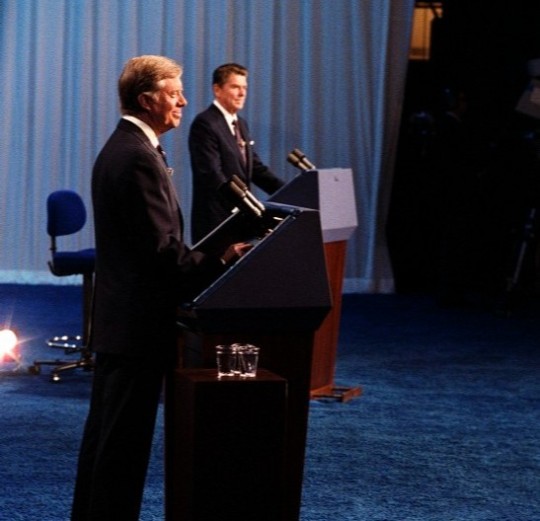

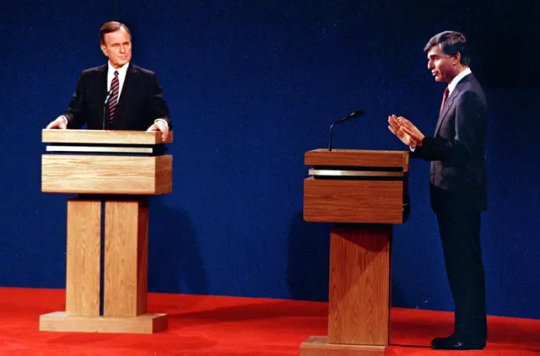

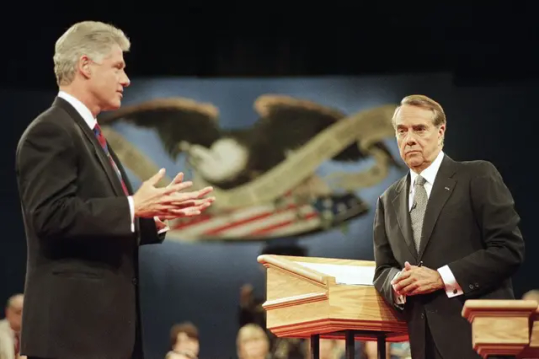
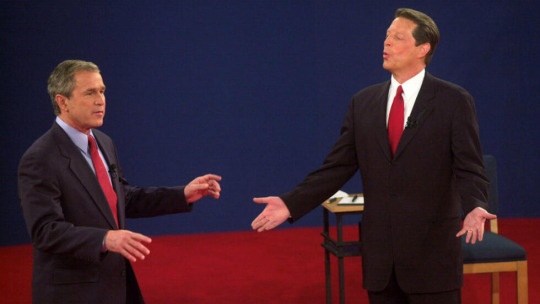
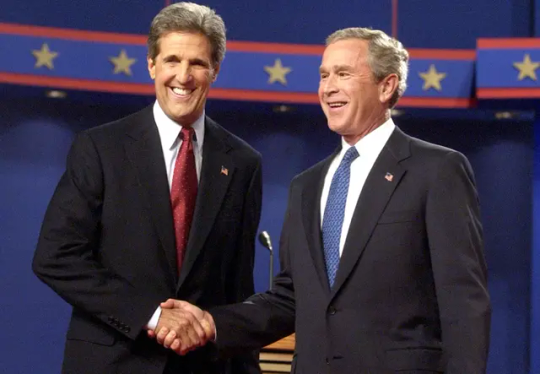
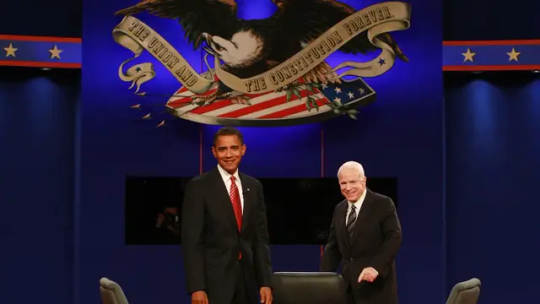
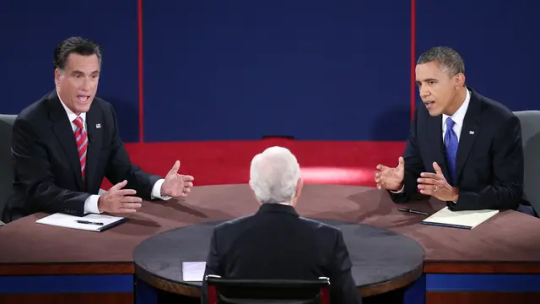

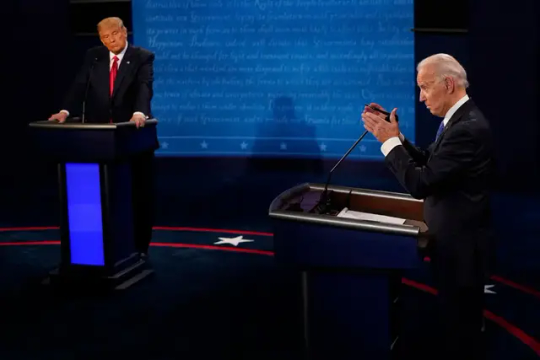
It's Presidential Debate Day and it's a historic one (and probably going to be the craziest one): -The first debate between two Presidents. -The earliest debate between two general election candidates ever. -The two oldest general election candidates ever (again). -The first debate between general election candidates to take place before the party conventions. -The first time a convicted felon has participated in a Presidential debate.
Previous Presidential debate matchups: •1960: Vice President Richard Nixon vs. Senator John F. Kennedy •1976: President Gerald R. Ford vs. former Georgia Governor Jimmy Carter •1980: President Jimmy Carter vs. former California Governor Ronald Reagan •1984: President Ronald Reagan vs. former Vice President Walter Mondale •1988: Vice President George H.W. Bush vs. Massachusetts Governor Michael Dukakis •1992: President George H.W. Bush vs. Arkansas Governor Bill Clinton vs. Ross Perot •1996: President Bill Clinton vs. Senator Bob Dole •2000: Vice President Al Gore vs. Texas Governor George W. Bush •2004: President George W. Bush vs. Senator John Kerry •2008: Senator John McCain vs. Senator Barack Obama •2012: President Barack Obama vs. former Massachusetts Governor Mitt Romney •2016: Former Secretary of State Hillary Clinton vs. Donald Trump •2020: President Donald Trump vs. former Vice President Joe Biden
#History#Presidents#Presidential Debate#Presidential Debates#Presidential History#2024 Election#Politics#Political History#Presidency#Presidential Politics#CNN Presidential Debate#Debate#CNN Debate#President Biden#Joe Biden#Donald Trump#President Trump#2024 Presidential Election#Presidential Election#Presidential Campaign
150 notes
·
View notes
Text
List of potential Vice President running mates
- Mike Pence
- the ghost of Richard Nixon
- Jair Bolsonaro
- the owner of four seasons total landscaping
- a flag from the J6 riot
- Big Mike from cell block c
- former President George Santos
- Alex Jones
- an un-hackable voting machine
- Eric
- Enrique Tarrio
- 11,000 votes from the state of Georgia
- the largest donor
- Tucker Carlson
430 notes
·
View notes
Text
Dick Cheney

Physique: Average Build Height: 5'8" (1.72 m)
Richard Bruce Cheney (born January 30, 1941) is an American retired politician and businessman who served as the 46th vice president of the United States from 2001 to 2009 under President George W. Bush. Often cited as the most powerful vice president in American history, Cheney previously served as White House Chief of Staff for President Gerald Ford, the U.S. representative for Wyoming's at-large congressional district from 1979 to 1989, and as the 17th United States secretary of defense in the administration of President George H. W. Bush. He is the oldest living former U.S. vice president, following the death of Walter Mondale in 2021.





Born in Lincoln, Nebraska, Cheney grew up there and in Casper, Wyoming. He attended Yale University before earning a Bachelor of Arts and Master of Arts in political science from the University of Wyoming. He began his political career as an intern for Congressman William A. Steiger, eventually working his way into the White House during the Nixon and Ford administrations.



Cheney ended his vice presidential tenure as a deeply unpopular figure in American politics with an approval rating of 13 percent. Being called names like Darth Cheney and the Prince of Darkness, Cheney was widely considered, by supporters and detractors alike, to be the biggest swing dick of a vice president in the history of America. Figuratively and literally. What? We’ve all seen the bulge pics. And with my thing for bad guys, I’d probably end up with two shots to the face, one being birdshots.





Anyway, he’s married for over 60 years to Lynne and together two daughters, Elizabeth ("Liz") and Mary Cheney, and seven grandchildren. And with his support of his gay daughter, Mary. Maybe… maybe I have a shot with him. Probably not, but with that being said, I’m still going have people tell me what a evil man he is (like I don’t know) and or what a bad guy I am for wanting to fuck him. YES… I can feel your hate. Star Wars reference… get it.


85 notes
·
View notes
Text
S.V. Dáte at HuffPost:
WASHINGTON ― For Donald Trump, Tuesday’s election has come to this: It’s either the White House or the Big House. If he wins, the coup-attempting former president, already a convicted criminal, will be able to postpone his Georgia and New York state prosecutions until he is no longer in office. As for his two federal cases, he would be able to make them disappear forever by simply ordering his attorney general to dismiss them. “Those will be dismissed on Jan. 20. Both of them,” said Ty Cobb, a former Trump White House lawyer and onetime federal prosecutor who thinks his old boss deserves prison time. “There’s a compelling interest for the country to deter this treasonous bullshit and the mishandling of sensitive information.” Trump himself confirmed he would end the federal prosecutions by firing special counsel Jack Smith in an interview last month with pro-Trump radio host Hugh Hewitt. “It’s so easy — I would fire him within two seconds,” Trump said. Smith has headed the election interference and classified documents investigations.
The New York and Georgia cases, meanwhile, would at best go into hibernation, lawyers said, because courts have ruled that presidents must have the ability to carry out their duties under the Constitution, notwithstanding state legal cases. “The state cases, because of the supremacy clause, nothing much will occur,” said Karen Agnifilio, a former prosecutor in Manhattan. “He can be sentenced in New York state, but he will not get anything that bleeds into his presidency. So maybe community service? A fine? Nothing?” A Trump victory over Democratic Vice President Kamala Harris would mark the first time in American history that voters have put a literal criminal into office. Among former presidents, only Richard Nixon even came close to facing charges for his attempt to cheat in the 1972 presidential election and his subsequent attempts to cover it up. He was preemptively pardoned by newly sworn-in Gerald Ford days after Nixon resigned from office in 1974.
Trump, in contrast, already faces three active criminal cases against him: in state court in Georgia, for his attempt to overturn his 2020 election loss there; in federal court in Washington, D.C., for his actions leading up to and during his Jan. 6, 2021, coup attempt; and in New York state court, for falsifying business records to hide a $130,000 hush money payment to a porn star days ahead of the 2016 election. There was a second federal prosecution, in South Florida based on Trump’s refusal to turn over secret documents he took with him to his Palm Beach country club upon leaving the White House, that was dismissed by U.S. District Judge Aileen Cannon. Smith is appealing to have those charges reinstated. The New York case would be his most immediate threat, should he lose. A New York City jury in May found him guilty on every count. Sentencing is now set for Nov. 26. Though it is a white-collar crime and Trump is still legally a first-time offender, Judge Juan Merchan can consider Trump’s lack of remorse, the seriousness of the crime ― intended to sway the 2016 presidential election ― as well as Trump’s multiple violations of Merchan’s gag order forbidding the former president from attacking witnesses and court officers in the case.
Today, this election will determine the fate of any chance of whether Donald Trump will be held accountable for his crimes.
If he loses, he’ll be in a heap of legal trouble. If he wins, he’ll be off scot-free.
#Donald Trump#Trump Indictment#2024 Presidential Election#2024 Elections#Trump Indictment IV#Trump Indictment III#Trump Indictment II#Georgia v. Trump#People of New York v. Trump#United States v. Trump#Ty Cobb#Jack Smith
20 notes
·
View notes
Text

Socks Clinton is the Former Cat of President Clinton's who lived in the White House. His name was inspired by his white paws which resemble those of the title character of the Beverly Cleary novel Socks. Buddy is the White House dog.



Pictured: Former White House Cat Socks Clinton showing shock at a suggested policy



Socks was to be the subject of a canceled 1993 video game entitled Socks the Cat Rocks the Hill for the Super NES and Sega Genesis platforms. The game was released in 2018. The premise was this:
Set in Washington D.C., Socks the Cat makes his way past spies, politicians, and the news media to warn the Clinton family of a stolen nuclear missile launch device. In one instance, Socks must push Millie the dog, pet of former president George H.W. Bush, out the front door to avoid Arab terrorist felines, as Richard Nixon calls in bomb raids.



Pictured: Former White House Cat Socks Clinton calling a press conference to discuss new foreign policies that include diplomacy with canines in Middle East
#socks clinton#buddy clinton#hillary clinton#bill clinton#cat#dog#animals#article#history#american history#1998#90s
20 notes
·
View notes
Text

LETTERS FROM AN AMERICAN
August 8, 2024
Heather Cox Richardson
Aug 09, 2024
Fifty years ago, on August 9, 1974, Richard M. Nixon became the first president in U.S. history to resign.
The road to that resignation began in 1971, when Daniel Ellsberg, who was at the time an employee of the RAND Corporation and thus had access to a top-secret Pentagon study of the way U.S. leaders had made decisions about the Vietnam War, leaked that study to major U.S. newspapers, including the New York Times and the Washington Post.
The Pentagon Papers showed that every president from Harry S. Truman to Lyndon B. Johnson had lied to the public about events in Vietnam, and Nixon worried that “enemies” would follow the Pentagon Papers with a leak of information about his own decision-making to destroy his administration and hand the 1972 election to a Democrat.
The FBI seemed to Nixon reluctant to believe he was being stalked by enemies. So the president organized his own Special Investigations Unit out of the White House to stop leaks. And who stops leaks? Plumbers.
The plumbers burglarized the office of Ellsberg’s psychiatrist in California, hoping to find something to discredit him, then moved on to bigger targets. Together with the Committee to Re-elect the President (fittingly dubbed CREEP as its activities became known), they planted fake letters in newspapers declaring support for Nixon and hatred for his opponents, spied on Democrats, and hired vendors for Democratic rallies and then scarpered on the bills. Finally, they set out to wiretap the Washington, D.C., headquarters of the Democratic National Committee, in the fashionable Watergate office complex.
Early in the morning of June 17, 1972, Watergate security guard Frank Wills noticed that a door lock had been taped open. He ripped off the tape and closed the door, but on his next round, he found the door taped open again. Wills called the police, who arrested five men ransacking the DNC’s files.
The White House immediately denounced what it called a “third-rate burglary attempt,” and the Watergate break-in gained no traction before the 1972 election, which Nixon and Vice-President Spiro Agnew won with an astonishing 60.7% of the popular vote.
But Bob Woodward and Carl Bernstein, two young Washington Post reporters, followed the sloppy money trail back to the White House, and by March 1973 the scheme was unraveling. One of the burglars, James W. McCord Jr., wrote a letter to Judge John Sirica before his sentencing claiming he had lied at his trial to protect government officials. Sirica made the letter public, and White House counsel John Dean immediately began cooperating with prosecutors.
In April, three of Nixon’s top advisors resigned, and in May the president was forced to appoint former solicitor general of the United States Archibald Cox as a special prosecutor to investigate the affair. That same month, the Select Committee on Presidential Campaign Activities, informally known as the Senate Watergate Committee, began nationally televised hearings. The committee’s chair was Sam Ervin (D-NC), a conservative Democrat who would not run for reelection in 1974 and thus was expected to be able to do the job without political grandstanding.
The hearings turned up the explosive testimony of John Dean, who said he had talked to Nixon about covering up the burglary more than 30 times, but there the investigation sat during the hot summer of 1973 as the committee churned through witnesses. And then, on July 13, 1973, deputy assistant to the president Alexander Butterfield revealed the bombshell news that conversations and phone calls in the Oval Office had been taped since 1971.
Nixon refused to provide copies of the tapes either to Cox or to the Senate committee. When Cox subpoenaed a number of the tapes, Nixon ordered Attorney General Elliot Richardson to fire him. In the October 20, 1973, “Saturday Night Massacre,” Richardson and his deputy, William Ruckelshaus, refused to execute Nixon’s order and resigned in protest; it was only the third man at the Justice Department—Solicitor General Robert Bork—who was willing to carry out the order firing Cox.
Popular outrage at the resignations and firing forced Nixon to ask Bork—now acting attorney general—to appoint a new special prosecutor, Leon Jaworski, a Democrat who had voted for Nixon, on November 1. On November 17, Nixon assured the American people that “I am not a crook.”
Like Cox before him, Jaworski was determined to hear the Oval Office tapes. He subpoenaed a number of them. Nixon fought the subpoenas on the grounds of executive privilege. On July 24, 1974, in U.S. v. Nixon, the Supreme Court sided unanimously with the prosecutor, saying that executive privilege “must be considered in light of our historic commitment to the rule of law. This is nowhere more profoundly manifest than in our view that 'the twofold aim (of criminal justice) is that guilt shall not escape or innocence suffer.'... The very integrity of the judicial system and public confidence in the system depend on full disclosure of all the facts….”
Their hand forced, Nixon’s people released transcripts of the tapes. They were damning, not just in content but also in style. Nixon had cultivated an image of himself as a clean family man, but the tapes revealed a mean-spirited, foul-mouthed bully. Aware that the tapes would damage his image, Nixon had his swearing redacted. “[Expletive deleted]” trended.
In late July 1974, the House Committee on the Judiciary passed articles of impeachment, charging the president with obstruction of justice, abuse of power, and contempt of Congress. Each article ended with the same statement: “In all of this, Richard M. Nixon has acted in a manner contrary to his trust as President and subversive of constitutional government, to the great prejudice of the cause of law and justice and to the manifest injury of the people of the United States. Wherefore Richard M. Nixon, by such conduct, warrants impeachment and trial, and removal from office.”
And then, on August 5, in response to a subpoena, the White House released a tape recorded on June 23, 1972, just six days after the Watergate break-in, that showed Nixon and his aide H.R. Haldeman plotting to invoke national security to protect the president. Even Republican senators, who had not wanted to convict their president, knew the game was over. A delegation went to the White House to deliver the news to the president that he must resign or be impeached by the full House and convicted by the Senate.
In his resignation speech, Nixon refused to acknowledge that he had done anything wrong. Instead, he told the American people he had to step down because he no longer had the support he needed in Congress to advance the national interest. He blamed the press, whose “leaks and accusations and innuendo” had been designed to destroy him. His disappointed supporters embraced the idea that there was a “liberal” conspiracy, spearheaded by the press, to bring down any Republican president.
LETTERS FROM AN AMERICAN
HEATHER COX RICHARDSON
#Letters From An American#Heather cox Richardson#Nixon#history#American History#the presidency#Watergate
21 notes
·
View notes
Text
Kissinger’s unwavering support for brutal regimes still haunts Latin America

In Chile, leftists were tortured, tossed from helicopters and forced to watch relatives be raped. In Argentina, many were “disappeared” by members of the brutal military dictatorship that held detainees in concentration camps.
It all happened with the endorsement of Henry Kissinger, the former U.S. secretary of state who died Wednesday at age 100.
As tributes poured in for the towering figure who was the top U.S. diplomat under Presidents Richard Nixon and Gerald Ford, the mood was decidedly different in South America, where many countries were scarred deeply during the Cold War by human rights abuses inflicted in the name of anti-communism and where many continue to harbor a deep distrust of their powerful neighbor to the north.
“I don’t know of any U.S. citizen who is more deplored, more disliked in Latin America than Henry Kissinger,” said Stephen Rabe, a retired University of Texas at Dallas history professor who wrote a book about Kissinger’s relationship with Latin America. “You know, the reality is, if he had traveled once democracy returned to Argentina, to Brazil, to Uruguay — if he had traveled to any of those countries he would have been immediately arrested.”
Continue reading,
#united states#us politics#henry kissinger#democracy#international politics#brazil#chile#argentina#uruguay#mod nise da silveira#image description in alt
61 notes
·
View notes
Text
#MiniatureMonday





The Mini Ketchup Cookbook / By Cameron Pearl
The Mini Ketchup Cookbook is filled with recipes, artwork, and fun facts, all centered around ketchup! This miniature book was published in 2006 by the Running Press Miniature Edition, and stands at only 84 mm tall.
Regardless of how you eat your ketchup; on sandwiches, with French fries, or on hot dogs, this book is perfect reading for everyone (especially foodies). It is a great book to appreciate art, cooking, history, and ketchup trivia!
Fun fact from the book: Former President Richard Nixon enjoyed eating ketchup on his cottage cheese.
--Adair J.
41 notes
·
View notes
Text
Gay TV Show Firsts
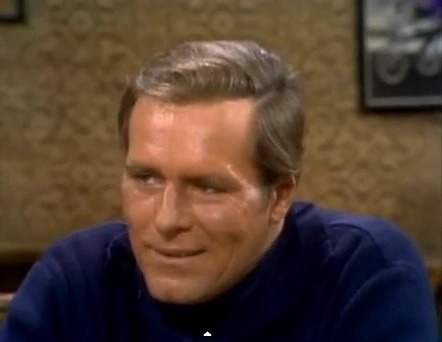
On February 9th, 1971 the first explicitly gay character “Steve” appeared on television in season 1 episode 5 “Judging Books by Covers” of the American sitcom All in the Family. This episode made its mark by portraying the opposite of the flamboyant stereotype of gay men (that the main character and best friend of Steve held to believe) by representing a gay man who was the complete opposite: masculine, tough, and a former football player. These attributes lead president at the time Richard Nixon to call out the show for “glorifying homosexuality”. Prior to this there were some coded and repressed gay and lesbian characters, but it was not as clear as to them being homosexual as it was on All in the Family.

The first same sex kiss ever on television was in Australian soap opera The Box in the first episode which premiered on February 11, 1974. The character Vicki Stafford (right) is canonically bisexual.

The American sitcom Hot l Baltimore which ran on ABC for one season in 1975, beginning January 24th, featured tv’s first gay couple, they were also main characters. There was much controversy for this at the time and the couple was not allowed to show any physical intimacy. There was also a viewer discretion warning at the beginning of each episode to warn for “mature themes”.

On February 7th, 1991 legal drama L.A. Law featured the first same sex kiss on American network television in the episode “He’s a Crowd”.
Controversy and support erupted and some advertisers removed their advertisements from the broadcast, while GLAAD praised the episode. One of the actresses reported that the kiss was a ratings ploy with no intention to explore a lesbian relationship. Both characters ended up with men.
This episode gave birth to the TV trope “lesbian kiss episode”, where a typically one off episode character that was a lesbian or bisexual woman would kiss a heterosexual female main character, played for shocks, laughs and ratings boots and is never mentioned again or explored further.

On October 20th of that same year Fox’s sitcom Roc featured the first gay wedding in season 1 episode 8 titled “Can’t Help Loving That Man”.
Writer of the episode Jeffrey Duteil said the audience was overwhelmingly supportive and that the network “couldn’t be more pleased” with how it turned out.


The first gay sex scene on television was a bit hard to confirm but I believe it to be from the original UK Queer as Folk which began airing February 23rd, 1999 and ran till February 22nd, 2000.
The US remake of the show which ran from December 3rd, 2000 - August 2nd 2005 was the first American show to feature gay sex. Both shows were very groundbreaking for their explicit portrayal of it.
#lesbian history#gay history#lgbtq#lgbt history#queer#all in the family#the box#hot l baltimore#l.a law#roc#queer as folk#tv/mov/docs#semi long post
35 notes
·
View notes
Text
A famous parable revolves around the troubled relationship between a scorpion and a frog. A scorpion needs to cross a river. Unable to swim, the scorpion asks a frog to carry him on his back. Listening to the request, the frog responds that he is hesitant because he fears that the scorpion will sting and kill him. After the scorpion assures his new friend that he would never do that, the frog agrees. Halfway through the journey, the scorpion stings the frog. Slowly dying, the frog asks, “Why did you do this?” The scorpion responds, “I’m sorry, but it’s in my nature.”
The story is a classic lesson about how dangerous people don’t usually change. Even when promising that they will act differently, the likelihood is that they won’t. It is also a tale about taking warning signs seriously. The frog understood the risks that he faced, yet he chose to ignore them.
U.S. presidential elections frequently involve warnings signs. Over the course of a campaign, voters learn a great deal about the candidates running and the potential costs of putting someone in office. Sometimes, a majority of voters decide to heed those warnings, yet there are other times in U.S. history when voters end up the frog.
In 2024, there are more warnings signs than usual about one of the major candidates: the Republican nominee, former President Donald Trump. There are big red flags from both his first term in office and his post-presidential years waving over and over about what Trump 2.0 would bring. Another one came on Wednesday, when the Washington, D.C., district judge handling the federal election conspiracy case against Trump unsealed a 165-page document with the fullest picture of what special counsel Jack Smith had found.
To understand how voters have the capacity to cover their ears to avoid hearing alarm bells, look back to 1972, when President Richard Nixon won reelection in a landslide victory against Democratic Sen. George McGovern. Too often, the story of Nixon’s reelection in 1972 and Watergate are treated separately. The thing is, there were, in fact, many people warning of who Nixon was as a politician and what he would likely do when freed from the restraints imposed by having to worry about reelection.
The familiar narrative on the 1972 election is that, riding high on diplomatic breakthroughs with the Soviet Union and China, Nixon defeated McGovern in a stunning victory that rivaled President Franklin Roosevelt’s coalition-building reelection win in 1936. There were many Americans who didn’t like Nixon or his policies, but it wasn’t until investigations in 1973 that his severe abuses of presidential power were revealed. Had the country only known more, so the story goes, the electorate could have averted the disaster they collectively faced on Aug. 9, 1974, when Nixon stepped onto a helicopter, leaving the White House in the middle of his second term.
In fact, numerous representatives and senators had been trying to expose Nixon’s nature even before that election. After Nixon announced on April 30, 1970, that he had secretly deployed troops to Cambodia and conducted a massive bombing campaign, there was a fierce outcry from Democrats about how he had lied and threatened the balance of power to accelerate a disastrous war. Idaho Sen. Frank Church and Kentucky Sen. John Sherman Cooper began drafting a bill to prohibit the president from using congressional funds for operations in Cambodia. Congressional critics railed against Nixon’s turn to impounding funds that they had appropriated and which he failed to veto. Soon after the break-in at the Democratic National Committee headquarters at the Watergate building in June 1972, Democratic Rep. Wright Patman, a Texas populist, attempted to launch an investigation into the connections he suspected between the burglars and Nixon’s reelection campaign. The effort, covered by the press, was undercut by Nixon and his allies on Capitol Hill.
Journalists and public intellectuals were on Nixon’s case long before most voters cast their ballot. In 1971, the administration’s efforts to prevent the press from publishing the Pentagon Papers, a secret Defense Department study exposing the lies told to justify the war in Vietnam, required the Supreme Court to intervene, culminating in the 6-3 decision in New York Times Company v. United States, which allowed publication. The media praised the decision as a blow to a president who was intent on stifling the press. In March 1972, Life published a story based on a nine-month investigation that accused the Nixon administration of having “seriously tampered with justice” to insulate supporters in San Diego from criminal prosecutions involving illegal campaign contributions. “The administration has in several instances taken steps to neutralize and frustrate its own law enforcement officials,” the magazine noted.
By mid-October 1972, the Washington Post, the New York Times, and Time were publishing stories about an FBI investigation into whether Nixon’s reelection team was involved in sabotage operations, including the break-in at the Watergate building, against the Democratic campaign. On Oct. 16, Bob Woodward and Carl Bernstein published a blockbuster story about how Nixon’s personal lawyer, Herbert Kalmbach, revealed that he “was one of five persons authorized to approve payments from the Nixon campaign’s secret intelligence gathering and espionage fund.” Nixon campaign manager Clark McGregor was so frustrated with reporters that he accused the press of acting politically, stating, “the Post has maliciously sought to give the appearance of a direct connection between the White House and the Watergate, a charge the Post knows—and a half dozen investigations have found—to be false.”
And then there was McGovern, who made Nixon’s corruption a major theme in his final months on the campaign trail. In his acceptance speech at the Democratic Convention, McGovern said, “From secrecy and corruption in high places, come home, America.” In late September, during visits to three states on the East Coast, McGovern called Nixon “scandal-ridden” and “corrupt.” Speaking to labor leaders in Atlantic City, he warned that “If we let this Nixon-Agnew administration have another four years, I think they’ll make Warren G. Harding look like a Sunday school teacher.” McGovern called the Nixon administration the “trickiest, most deceitful” in U.S. history. On Oct. 17, he told a rally in Fort Worth, Texas, that Nixon was attempting to “escape responsibility” for the break-in and, in the process, “polluting the faith of the American people in government itself.”
McGovern’s emphasis on corruption intensified in the final weeks of his campaign. “As the net of truth closes tighter and tighter around the president himself,” he said, “they try to persuade us that the spying, and lying, and burglary, and sabotage will not affect the election because people expect these things of politicians.” If voters chose Nixon, he said, they would be selecting four years of “Watergate corruption.”
The problem was that McGovern was running against the wind. In mid-October, Gallup found that a minute percentage of Americans ranked corruption as a top issue; only 52 percent had even heard of the Watergate affair. The public concluded that both parties were equally corrupt, so it didn’t matter who was in office.
Nixon defeated McGovern by winning 49 states, including a sweep of the South, and 60.7 percent of the vote.
Today, the warning signs about Trump are all in broad daylight.
The first threat is Trump’s embrace of election denialism. The former president demonstrated that he is willing to destabilize the democratic system when election results don’t go his way. Multiple investigations have unpacked the systematic campaign by Trump and his allies to overturn the 2020 election, which culminated in the violence of Jan. 6, 2020. Since the insurrection, Trump has continued to deny the outcome—as did Sen. J.D. Vance during his debate against Gov. Tim Walz, when he refused to acknowledge that Joe Biden won. Moreover, the Trump campaign has made several strategic moves, such as supporting a change of rules by Trump-allied members of the Georgia State Election Board that will make it easier for local officials to question and delay the counting of ballots; this could easily create a certification crisis.
During his time in office, Trump refused to accept that there were limitations on what a president could do. Surrounded by advisors who believed in the unitary executive theory, Trump did what he wanted to do until someone was able to stop him. Formal or informal guardrails were not his thing. Trump’s expansive, and dangerous, views of presidential power were clear during the first impeachment trial when the United States learned how he had threatened congressionally appropriated aid to Ukraine if Ukrainian President Volodymyr Zelensky did not agree to help dig up dirt on Biden and his son. Trump and his supporters were very clear that he will flex even more of that muscle should he be given another chance to do so. He has often spoken in public about collapsing the firewall that has separated the president from the Justice Department since Nixon’s downfall, and he has threatened to use that prosecutorial power to go after his opponents. In one Truth Social post about Smith’s investigation, Trump said that there would be “repercussions far greater than anything that Biden or his Thugs could understand.” Written by many high-level officials in Trump’s operation, including Stephen Miller, Project 2025 is a 900-page road map to a massive expansion of executive power.
Finally, Trump poses a serious risk to human rights. Between 2017 and 2021, undocumented immigrants were subject to intense and inhumane punitive measures, such as the separation of families, in an effort to disincentivize border crossings. In response to #BlackLivesMatter, Trump asked former Defense Secretary Mark Esper about shooting civil rights protesters in 2020. He famously had peaceful protesters in Lafayette Park cleared out with tear gas all so that he could get a photo-op. Finally, he was the instrumental force behind the creation of the 6-3 majority on the Supreme Court that overturned Roe v. Wade.
The United States paid a high price for its decision in 1972. Nixon’s second term was consumed by the Watergate scandal, which rocked U.S. politics, traumatized and divided the nation, and resulted in decades of deep distrust of government. In 2024, will voters heed the warning signs?
43 notes
·
View notes
Text
youtube
"When the President does it, that means it is not illegal." -- Former President Richard Nixon, 1977 Also: the United States Supreme Court, 2024.
#History#SCOTUS#Supreme Court#Presidential Immunity#Trump Immunity Case#Frost/Nixon#Richard Nixon#President Nixon#Presidency#Youtube
80 notes
·
View notes
Photo

A telegram from George Harrison to President Nixon, dated August 16, 1973 (courtesy of U.S. Citizenship and Immigration Services via Kansas City Star).
“A handwritten note on top of the telegram asks, ‘Is this one of the former Beatles?’ Yes, it was. The telegram, a terse protest of the bombing of Cambodia, was addressed to then-President Richard Nixon and sent to the White House by George Harrison on August 16, 1973. […] Harrison’s records are noteworthy because they help complete a story of government paranoia, of Nixon’s exploitation of federal agents to undercut what was then growing youth dissent toward the Vietnam War. Not a small factor was Nixon’s own fear that he wouldn’t be re-elected in 1972. [...] He’d previously been granted entry, despite officials knowing about the 1969 conviction. Here is the text of the telegram, retaining the misspellings [of the transcriber] and garbled syntax: ‘Sir how can you bomb Cambonian [sic] citizens and worry about kicking me out of the country for smoking marijuana at the time. Your repressive emperaour [sic] war monger ways stop before too piece luv we will run the world Harry Krisher Hare Hara Krishne Hare Hara Hare Hara Krishner [sic]. George Harrison.’” - The Kansas City Star, August 11, 2017 (x)
#George Harrison#quote#quotes about George#quotes by george#Harrison correspondence#1973#1970s#beware of greedy leaders#Concert for Bangladesh#fits queue like a glove
134 notes
·
View notes
Text
https://www.washingtonpost.com/opinions/2023/10/12/southern-strategy-kevin-phillips-republican-party-trump/
Opinion The GOP’s ‘southern strategy’ mastermind just died. Here’s his legacy.
Greg Sargent
“The whole secret of politics is knowing who hates who.”
That insight was the brainchild of Kevin Phillips, the longtime political analyst who passed away this week at 82 years old. Phillips’s 1969 book, “The Emerging Republican Majority,” provided the blueprint for the “southern strategy” that the Republican Party adopted for decades to win over White voters who were alienated by the Democratic Party’s embrace of civil rights in the 1960s.
Phillips advised Republicans to exploit the racial anxieties of White voters, linking them directly to issues such as crime, federal spending and voting rights. The strategy, beginning with Richard M. Nixon’s landslide victory in the 1972 presidential race, helped produce GOP majorities for decades.
Though Phillips later reconsidered his fealty to the GOP, updated versions of the “southern strategy” live on in today’s Republican Party, shaping the political world we inhabit today. So I asked historians and political theorists to weigh in on Phillips’s legacy. Their responses have been edited for style and brevity.
Kevin Kruse, historian at Princeton University and co-editor of “Myth America”: Kevin Phillips was a prophet of today’s polarization. He drew a blueprint for a major realignment of American politics that is still with us. For much of the 20th century, Democrats dominated the national scene, because of the reliable support of the “Solid South.”
But the “Negro problem” of the 1960s, Phillips argued, presented Republicans an opportunity to take the South and Southwest, too, a new region he anointed “the Sun Belt.” All they had to do was appeal to the hatreds of White voters there, through racially coded “law and order” appeals.
Phillips, of course, proved correct about the regional realignment. Republicans won every single state in the South in the 1972, 1984, 1988, 2000 and 2004 presidential campaigns. Today, Republicans dominate the region partly because they still employ Phillips’s polarizing politics of resentment and reaction, from complaints about Black Lives Matter to panics about “woke” education. Donald Trump’s continued dominance of the GOP shows that the underlying instinct to exploit division and inflame hatred remains.
Nicole Hemmer, author of “Partisans: The Conservative Revolutionaries who Remade American Politics in the 1990s”: Phillips helped shape how the Republican Party navigated the last 50 years of U.S. politics. His big contribution was the idea that White southerners could be potential voters for the GOP, because the solid Democratic South had become newly fractured after President Lyndon B. Johnson signed the Civil Rights Act and the Voting Rights Act.
Phillips argued that the Republican Party needed to change the way it conducted politics to reach out to disaffected White southerners. For Nixon, that was “law and order,” something Ronald Reagan used to great effect along with stories about “welfare queens.” George H.W. Bush’s campaign ran the “Willie Horton” ad, which played up fears of Black criminality.
Trump picked up this rhetoric. He launched his campaign on the ideas of Mexican migrant and Muslim criminality — that all these minority populations needed to be under much stricter surveillance.
The strategy that Phillips helped popularize worked just as well with some northern White voters as it did with southern White voters. It helped solidify the Republican Party’s base as almost exclusively White even as the nation has grown more diverse.
Bill Kristol, a former Republican turned Never Trump conservative: It was happening already in 1968, but Phillips’s book and his subsequent promotion of the southern strategy did have the effect of making that reaction to the civil rights movement more coherent. It gave politicians a way to think about shaping that reaction politically.
Newt Gingrich, who defeated lots of Democrats in southern House seats in the 1994 midterms, was in spirit a Phillips protégé. That culminated in 2010, when Democrats got obliterated, and in the red state-blue state divide today.
From Phillips to Ron DeSantis and Greg Abbott, there is a through line. DeSantis, Abbott and others are operating in a world anticipated and partly created by Phillips. The reaction of much of the White working class and Republican politicians to Black Lives Matter and “cosmopolitan elites” is a close cousin of what Phillips predicted and helped shape.
Michael Barone, senior political analyst for the Washington Examiner: I think Phillips was noticing what was happening rather than causing it to happen. Dwight D. Eisenhower got 49 to 50 percent of the popular vote in the South in 1952 and 1956; Nixon got nearly that much in 1960. When the national Democratic Party became more dovish, circa 1967, reacting against the Vietnam escalations of its own presidents, Southern Whites — always the most hawkish voters — turned away from national Democrats not so much because of civil rights but because of dovishness. It’s what Tom Eagleton later told Robert Novak: “acid, amnesty, and abortion.”
Corey Robin, political theorist and author of “The Reactionary Mind”: Phillips understood that the old Republican Party establishment could not begin to take on the New Deal and Great Society until it developed a mass popular base. He saw that the White working class — not just in the South, but in the North — was growing disaffected with the New Deal on economic and racist grounds, and that Republicans could turn that dissatisfaction into governing majorities.
Beginning in 1972 with the reelection of Nixon, Republicans built this majority in the spirit of what Phillips imagined. George W. Bush, the last Republican president to get a popular majority, was the last spasm of that vision. The irony is that, under Phillips, the idea was to expand the Republican Party into a permanent governing majority.
But once the White working class diminished, the electoral return of that resentment dramatically dwindled. As a result, instead of relying on robust electoral majorities, the Republican Party, to win power, relies on the electoral college and the malapportioned Senate. Phillips’s blueprint made the heyday of Republican power — and ultimately unmade it.
58 notes
·
View notes